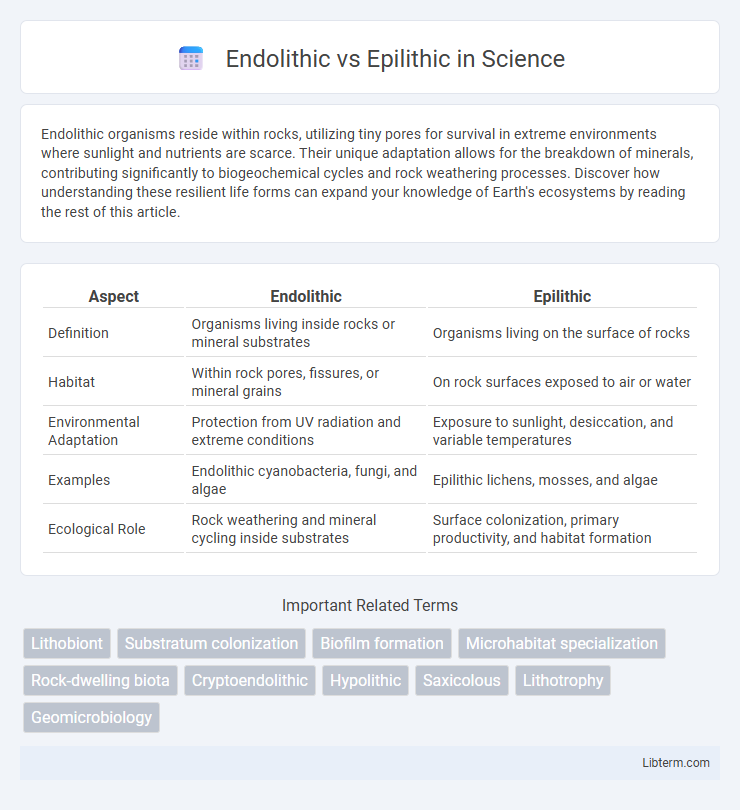Endolithic organisms reside within rocks, utilizing tiny pores for survival in extreme environments where sunlight and nutrients are scarce. Their unique adaptation allows for the breakdown of minerals, contributing significantly to biogeochemical cycles and rock weathering processes. Discover how understanding these resilient life forms can expand your knowledge of Earth's ecosystems by reading the rest of this article.
Table of Comparison
| Aspect | Endolithic | Epilithic |
|---|---|---|
| Definition | Organisms living inside rocks or mineral substrates | Organisms living on the surface of rocks |
| Habitat | Within rock pores, fissures, or mineral grains | On rock surfaces exposed to air or water |
| Environmental Adaptation | Protection from UV radiation and extreme conditions | Exposure to sunlight, desiccation, and variable temperatures |
| Examples | Endolithic cyanobacteria, fungi, and algae | Epilithic lichens, mosses, and algae |
| Ecological Role | Rock weathering and mineral cycling inside substrates | Surface colonization, primary productivity, and habitat formation |
Introduction to Endolithic and Epilithic Organisms
Endolithic organisms live inside rocks, utilizing microscopic pores and cracks to penetrate and inhabit mineral substrates, contributing to rock weathering and nutrient cycling in extreme environments. Epilithic organisms grow on the surface of rocks, forming biofilms or mats that play essential roles in ecosystem primary production and habitat stabilization. Both endolithic and epilithic communities exhibit adaptations to harsh conditions such as high UV radiation, desiccation, and nutrient scarcity, making them critical components of terrestrial and marine lithic ecosystems.
Defining Endolithic: Life Within Rocks
Endolithic organisms inhabit the interior of rocks, thriving in microscopic spaces within mineral substrates where they extract nutrients and moisture. These microorganisms, including bacteria, fungi, and algae, adapt to extreme environments by living beneath rock surfaces, unlike epilithic species that reside on rock exteriors. The endolithic lifestyle offers protection from environmental stressors such as UV radiation and desiccation, enabling survival in harsh ecosystems like deserts and polar regions.
What Are Epilithic Organisms?
Epilithic organisms inhabit the surface of rocks, deriving nutrients and stability by attaching themselves externally rather than penetrating the substrate. These organisms include diverse algae, lichens, and cyanobacteria that form biofilms or crusts visible on rock exteriors in aquatic and terrestrial environments. Their ecological role involves colonizing exposed rock surfaces, contributing to nutrient cycling and providing a habitat for microfauna.
Distinct Habitats: Inside vs. On the Rock Surface
Endolithic organisms inhabit the interior of rocks, penetrating microscopic cracks and pores, while epilithic organisms reside on the exterior surfaces of rocks, exposed directly to environmental elements. Endoliths benefit from protection against desiccation and UV radiation by living inside the rock matrix, whereas epilithic communities adapt to varying temperature fluctuations and moisture availability on rock surfaces. The contrasting habitats influence physiological adaptations, with endolithic species often evolving mechanisms for low-light photosynthesis and epilithic species developing tolerance to harsher external conditions.
Adaptations for Survival: Endolithic vs. Epilithic Strategies
Endolithic organisms adapt for survival by colonizing the interior of rocks, using microhabitats within mineral matrices to shield against extreme UV radiation, desiccation, and temperature fluctuations while extracting nutrients from the substrate. Epilithic organisms thrive on rock surfaces, often developing protective pigments, biofilms, and efficient water retention systems to withstand direct environmental stresses such as intense sunlight and moisture variability. These contrasting survival strategies reflect specialized physiological and biochemical adaptations enabling endurance in harsh, exposed lithic ecosystems.
Ecological Roles and Functions
Endolithic organisms colonize the interior of rocks, contributing to bio-weathering and mineral cycling by penetrating and breaking down mineral substrates, which fosters nutrient availability in extreme environments. Epilithic organisms, such as lichens and algae, grow on rock surfaces, playing a crucial role in primary production, soil formation, and providing habitats for microfauna. Both ecological functions support ecosystem stability and nutrient dynamics, with endoliths facilitating internal rock alteration and epiliths enhancing surface colonization and energy capture.
Methods of Study and Identification
Endolithic and epilithic organisms are studied using microscopy techniques such as scanning electron microscopy (SEM) and confocal laser scanning microscopy (CLSM) to observe their spatial distribution within or on rock surfaces. Molecular methods including DNA sequencing and fluorescent in situ hybridization (FISH) enable precise identification and differentiation of endolithic communities embedded inside rocks versus epilithic ones living on rock surfaces. Analytical techniques like Raman spectroscopy and X-ray diffraction further assist in characterizing mineral interactions unique to each lifestyle, facilitating comprehensive ecological and taxonomic studies.
Environmental Influences on Endolithic and Epilithic Life
Environmental influences on endolithic and epilithic life vary significantly due to their distinct habitats; endolithic organisms reside within rock substrates, providing protection from extreme temperature fluctuations, UV radiation, and desiccation, while epilithic organisms grow on rock surfaces and are more exposed to environmental stressors like direct sunlight, wind, and moisture variability. Endolithic life forms benefit from microhabitats that moderate external environmental extremes, allowing for survival in harsh, arid, or polar environments where epilithic communities might struggle. Epilithic organisms depend heavily on ambient conditions such as precipitation and nutrient deposition, which directly affect their growth, photosynthesis, and overall ecological distribution.
Importance in Geological and Biological Cycles
Endolithic organisms live within rocks, playing a crucial role in geological weathering by breaking down minerals and contributing to soil formation, which influences nutrient cycles and ecosystem sustainability. Epilithic organisms grow on rock surfaces and are vital in primary colonization, promoting biofilm development and facilitating energy flow through photosynthesis, thus impacting biological productivity and carbon cycling. Both endolithic and epilithic communities are essential in maintaining the balance of biogeochemical processes and supporting biodiversity in extreme environments.
Comparative Summary: Endolithic versus Epilithic
Endolithic organisms inhabit the interior of rocks and substrates, thriving within microscopic pores and fissures, while epilithic organisms live on the surface of rocks. Endolithic species often benefit from protection against environmental extremes such as UV radiation and desiccation, whereas epilithic species have greater exposure to light for photosynthesis but face harsher external conditions. The metabolic adaptations of endoliths include slower growth rates and specialized biofilm formation, contrasting with epiliths' reliance on surface nutrient absorption and faster colonization.
Endolithic Infographic

 libterm.com
libterm.com